
What is Karate?
The word karate is derived from the Japanese characters kara and te, meaning empty hand. The suffix -do is added to include the word “way.” Karate then is a way of life, and not just a fighting fashion. It is a self-defense mechanism that incorporates concepts for self-improvement and greater focus and awareness. The practice of karate can be summed up in three aspects basics, forms, and sparring. Karate is a striking art that teaches punches, kicks, open-hand strikes and self-defense tactics while practicing proper breathing to harness strength from within. Many karate styles allow the use of weapons (such as nunchucks) as well for fending off an enemy. Derived from farming tools, some of the weapons originated centuries ago at a time when weapons were banned in Okinawa.
History of Karate
Karate is a Japanese martial art whose physical aspects seek the development of defensive and counterattacking body movements. The discipline and unremitting efforts required for training promote this. Karate is a centuries-old fighting system. It’s described as a martial art or a fighting method that involves a number of techniques to disable an opponent. Okinawa, 400 miles south of Japan, is the birthplace of karate. Karate became popular in the late 1300s when trade relationships were established between the Ryukyu Islands and the Fujian Province of China. This event spurred many families to relocate to Okinawa where they would share a blend of Chinese and Indian fighting styles known as Kenpo. Eventually, the techniques evolved and people began incorporating Southeast Asian influences. Karate did not become an accepted mainstream method of fighting until centuries later. Anko Itosu is credited as the grandfather of karate because he created a simplified system of forms for novice students. Many of Itosu’s forms are widely practiced today. In the Western world, karate is viewed as art that instills confidence, cooperation, strength, and self-discipline in those who practice it. People of all ages can learn karate, and there are throngs of schools that teach various styles to eager learners.
Why Karate?
Self-defense is just one of the many reasons people turn to karate. Among the other important reasons are:
- Focus: Karate helps practitioners focus as they learn to follow methodical movements and deep breathing to center the mind and body.
- Physical Fitness: Through the practice of basic movements, a karate practitioner becomes more balanced, flexible, coordinated, and physically fit.
- Confidence: Karate teaches students to overcome fear. As a student builds his or her endurance and works toward mastering basic movements, he or she naturally develops an improved self-image and confidence in his or her abilities.
Combination of custom patches and karate:
Karate enthusiasts know that their uniform is a source of pride, and should always be clean and free from wrinkles or debris. A spotless uniform is a visible, unspoken sign of self-respect and discipline. It shows reverence for one’s instructor, classmates, and the dojo (studio) where the student hones his or her skills. Karate Custom Patches are bold emblems that mark achievement and add value to any uniform.

